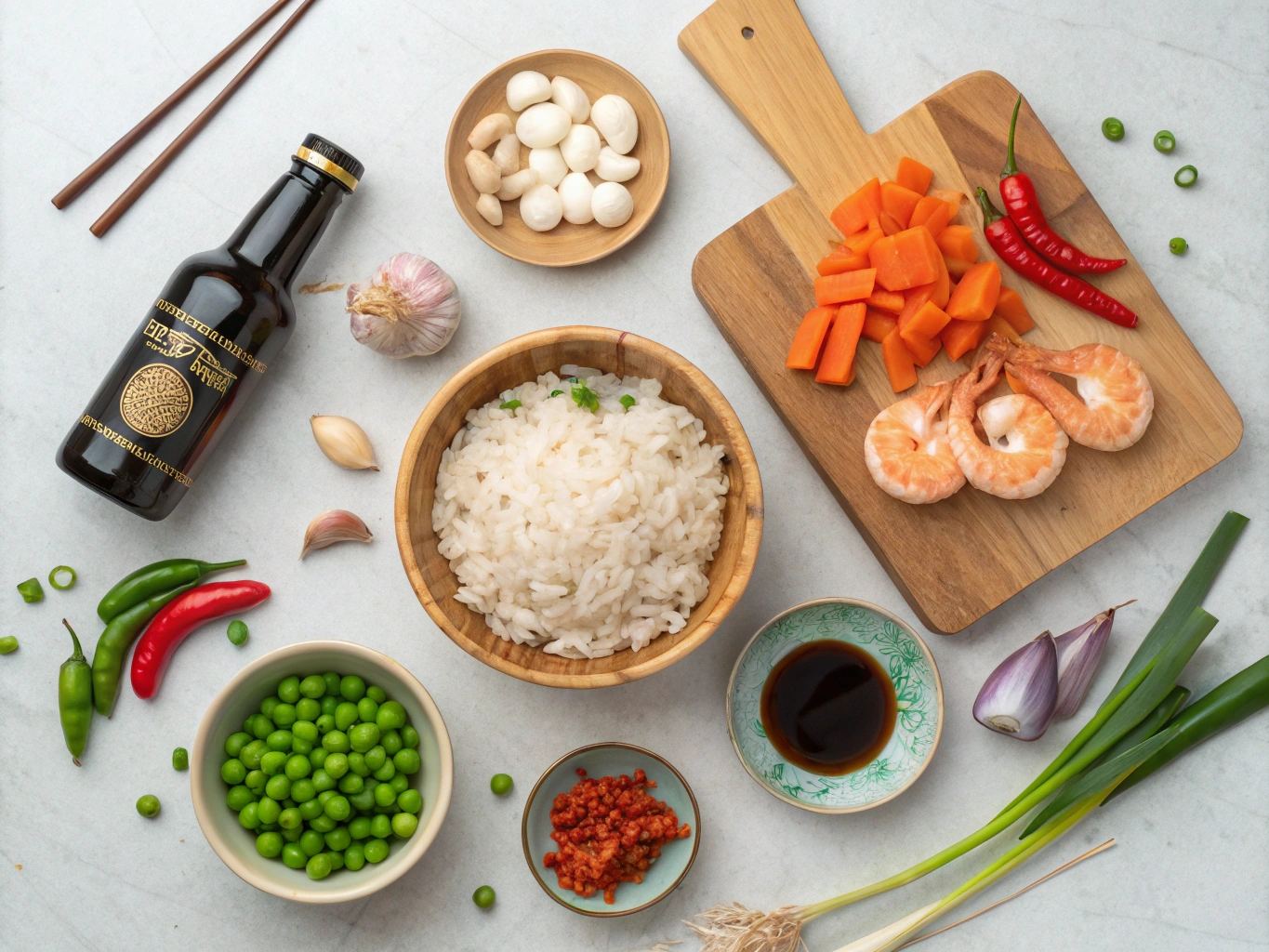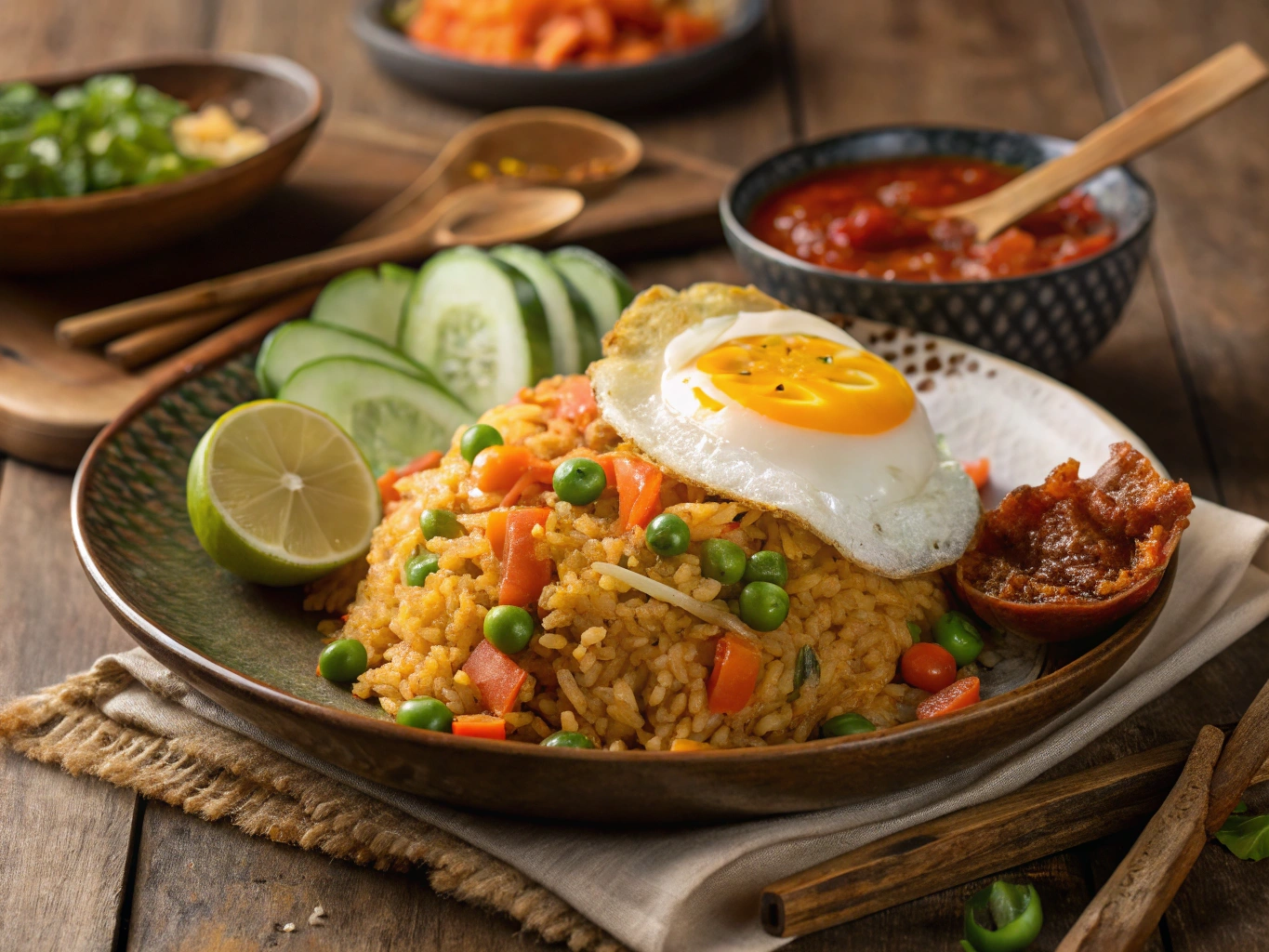Table of Contents
The first time I tasted authentic nasi goreng was on a humid evening in Jakarta, seated at a simple wooden table as the bustling night market pulsed around me. The plate arrived steaming, crowned with a perfectly fried egg, its edges crispy and lacy. That first forkful—fragrant with kecap manis, aromatic with shallots and garlic, and dancing with the perfect balance of sweet, savory, and spicy—was a revelation. In that moment, I understood why this humble fried rice dish has become Indonesia’s unofficial national dish and beloved comfort food across Southeast Asia. Every family has their recipe, every region its variation, but the soul of nasi goreng remains the same: transforming yesterday’s plain rice into today’s crave-worthy meal that tells the story of Indonesia’s rich culinary heritage.
As you embark on your own nasi goreng journey, you’ll discover that creating this iconic dish requires more than just tossing leftover rice in a pan. It demands understanding the cultural context, mastering specific techniques, and appreciating the delicate balance of flavors that makes nasi goreng distinctly Indonesian. Let this guide take you through every step of creating the perfect plate of nasi goreng—from selecting the right ingredients to achieving that elusive wok hei that elevates good fried rice to unforgettable.
The Cultural Significance of Nasi Goreng in Indonesia
The Origins and Evolution of Indonesia’s Most Famous Dish
Nasi goreng, which literally translates to “fried rice” in Indonesian, emerged primarily as a practical solution to avoid wasting food. In tropical Indonesia, where refrigeration was historically limited, yesterday’s rice would quickly spoil in the humid climate. Frying leftover rice with spices and whatever ingredients were available became not just a clever way to repurpose food but an art form in itself.
During the Dutch colonial period (1800-1945), Indonesian cuisine began incorporating foreign influences. The Chinese brought their fried rice techniques, while the Dutch trading connections introduced ingredients like shallots that would become fundamental to nasi goreng’s flavor profile. Over generations, these influences merged with indigenous cooking methods and ingredients to create what we now recognize as nasi goreng.
- Bist Amazon Picks:
What began as humble home cooking has risen to become Indonesia’s de facto national dish—so beloved that former President Barack Obama famously mentioned it as one of his childhood favorites from his time living in Jakarta. Today, you’ll find nasi goreng everywhere from roadside warung (food stalls) to high-end restaurants, each with its own signature interpretation.
What Makes Nasi Goreng Different from Other Asian Fried Rice Dishes
While many Asian cultures have their version of fried rice, several key elements distinguish nasi goreng from its cousins:
- Kecap manis dominance: The sweet, thick soy sauce creates the signature caramelized flavor and deep mahogany color unique to Indonesian fried rice.
- Bumbu paste foundation: Indonesian cooking relies heavily on spice pastes as flavor bases, giving nasi goreng its aromatic complexity.
- Terasi (shrimp paste): This pungent fermented ingredient provides depth and umami that sets Indonesian fried rice apart.
- Serving style: Traditional nasi goreng is typically crowned with a sunny-side-up fried egg and accompanied by crispy shrimp crackers (kerupuk) and fresh vegetables or pickles (acar).
Unlike Chinese fried rice, which often emphasizes the distinct separation of ingredients, nasi goreng embraces a more unified flavor profile where the rice itself carries the primary taste. Thai fried rice might prioritize fish sauce and basil, while Malaysian nasi-goreng often includes belacan (similar to terasi) but lacks the distinctive sweetness of Indonesian versions.
Essential Ingredients for Authentic Nasi Goreng
The Building Blocks of Perfect Nasi Goreng
To create truly authentic nasi goreng at home, you’ll need to gather several key ingredients that form the foundation of this iconic dish:

| Ingredient | Role in Nasi-Goreng | Notes |
|---|---|---|
| Day-old rice | Provides ideal texture | Freshly cooked rice is too moist and sticky |
| Kecap manis | Sweet soy foundation | Cannot be substituted with regular soy sauce |
| Shallots | Aromatic base | Milder and more complex than regular onions |
| Garlic | Aromatic base | Use fresh, never pre-minced |
| Terasi/shrimp paste | Umami foundation | Small amount provides depth without fishiness |
| Sambal or fresh chilies | Heat element | Adjust according to preference |
| Vegetables | Texture and nutrition | Typically minimal: green onions, carrots, peas |
| Protein options | Customization element | Chicken, shrimp, beef, or combination |
| Fried egg | Traditional topping | Sunny-side up with crispy edges |
Understanding Kecap Manis: The Secret Weapon of Nasi-Goreng
If there’s one non-negotiable ingredient in authentic nasi-goreng, it’s kecap manis (sometimes spelled ketjap manis). This viscous, molasses-like sweet soy sauce provides the distinctive caramelized flavor and mahogany color that defines Indonesian fried rice.
Unlike regular soy sauce, kecap manis contains significant amounts of palm sugar, creating a thick consistency and complex sweetness that balances perfectly with savory elements. The sauce isn’t merely an additive—it’s the foundational flavor that transforms simple fried rice into nasi-goreng.
When shopping for kecap manis, look for brands like ABC, Bango, or Cap Bango, which are widely recognized in Indonesia for their authentic flavor profiles. If you can’t source kecap manis locally or online, you can create a reasonable substitute by simmering equal parts regular soy sauce and palm sugar (or brown sugar) until the mixture reaches a syrupy consistency—though purists will note the difference.
Traditional vs. Modern Adaptations of Key Ingredients
While traditionalists might insist on specific ingredients, modern home cooks can make reasonable substitutions without sacrificing the essence of nasi-goreng:
- Shallots vs. onions: Shallots provide a milder, more complex flavor, but red onions can substitute in a pinch.
- Terasi alternatives: While traditional shrimp paste delivers unique depth, vegetarians might use miso paste or mushroom powder for similar umami notes.
- Chili variations: Traditional bird’s eye chilies deliver intense heat, but any fresh chili variety can work—adjust quantity to your spice preference.
- Rice options: Jasmine rice is traditional, but any long-grain variety works well when properly cooled and dried.
Remember that while adaptations are acceptable, certain elements—particularly the kecap manis—are fundamental to creating true nasi-goreng rather than a generic fried rice dish.
Mastering the Nasi Goreng Cooking Process
Essential Equipment for Perfect Nasi-Goreng
The right tools can significantly impact your nasi goreng results:

- Wok considerations: A carbon steel wok transfers heat quickly and develops the desirable “wok hei” flavor compounds. However, a large cast-iron skillet can serve as an effective alternative if a wok isn’t available.
- Heat source: Gas stoves provide the responsive high heat ideal for fried rice, but electric cooktops can work if you preheat thoroughly and maintain consistent temperature.
- Wooden spatula: Traditional Indonesian cooks use a wooden spatula rather than metal to protect their woks and effectively toss ingredients.
- Mortar and pestle: While not strictly necessary (a food processor can substitute), grinding your spice paste by hand releases oils more effectively and creates superior flavor complexity.
Step-by-Step Nasi Goreng Preparation Method
Creating exceptional nasi-goreng requires more than just following a recipe—it demands understanding the process and why each step matters:
- Prepare your rice properly: Ideally, cook your rice the day before with slightly less water than usual, then refrigerate uncovered. This dries the grains and prevents clumping. Before cooking, separate any clumps with your fingers.
- Create your bumbu paste: Combine shallots, garlic, terasi, and chilies in a mortar and pestle (or food processor) and grind to a semi-smooth paste. This aromatic foundation flavors the entire dish.
- Heat your wok properly: A properly heated wok is crucial—wait until it just begins to smoke before adding oil. This prevents sticking and promotes caramelization.
- Cook in the right order: Start by frying your bumbu paste until fragrant (1-2 minutes), then add proteins until nearly cooked. Add vegetables briefly, then rice, tossing continuously.
- Apply seasonings correctly: Add kecap manis and other seasonings around the sides of the wok where they’ll caramelize before mixing with rice. This creates deeper flavor than mixing directly.
- Keep it moving: Continuous tossing prevents burning while promoting even cooking. The rice should spend no more than 4-5 minutes total in the wok.
- Prepare the perfect fried egg: In Indonesian tradition, the egg is fried in plenty of hot oil until the edges become crispy and lacy while the yolk remains runny—a perfect textural contrast to the rice.
The Art of Wok Hei: Creating the “Breath of the Wok”
Wok hei—literally “breath of the wok”—refers to the distinctive smoky flavor compounds created when ingredients are cooked at very high temperatures in a well-seasoned wok. This elusive quality separates restaurant-quality nasi-goreng from home versions.
To maximize wok hei in your home kitchen:
- Preheat your wok until it’s smoking hot before adding oil
- Cook in small batches—overcrowding reduces temperature and prevents proper caramelization
- Keep ingredients moving constantly with a tossing motion rather than stirring
- Allow momentary “flare-ups” when tossing (if using gas)—these brief flames contribute to the smoky flavor
Remember that good ventilation is essential when cooking at these high temperatures!
Troubleshooting Common Nasi Goreng Problems
Even experienced cooks encounter challenges when making nasi-goreng. Here are solutions to common issues:
- Soggy rice: Spread cooked rice on a baking sheet and refrigerate uncovered for 30 minutes before cooking. If already soggy, try cooking slightly longer to evaporate excess moisture.
- Bland flavor: Increase terasi slightly for more umami depth, and ensure your wok is hot enough to develop proper caramelization.
- Burning spices: Your heat may be too high initially—cook bumbu paste at medium-high before increasing heat for the rice.
- Clumping rice: Break up clumps by hand before cooking, and ensure rice is cool and dry before it hits the wok.
Regional Variations of Nasi Goreng
Exploring Indonesia’s Diverse Nasi Goreng Landscape
Indonesia’s archipelago of over 17,000 islands has developed countless regional interpretations of nasi-goreng, each reflecting local ingredients and cultural influences:
- Nasi Goreng Kampung (Village Style): Found throughout rural Indonesia, this version embodies rustic simplicity—featuring just a few key ingredients including plenty of shallots, chili, and often anchovies (ikan bilis). The flavor is clean and straightforward.
- Nasi Goreng Seafood: Common in coastal areas like Makassar and Manado, these versions incorporate abundant fresh seafood—often shrimp, squid, and fish—with regional spice blends that frequently include more ginger and lemongrass.
- Nasi Goreng Pedas: Particularly popular in Padang (West Sumatra), this fiery variation incorporates significantly more chilies, often including the notoriously hot Padang-style sambal that leaves your lips tingling.
- Nasi Goreng Kambing: Found in areas with Middle Eastern influence like Jakarta, this version includes goat meat and additional spices like cumin and coriander, reflecting Indonesia’s historical trade connections.
- Nasi Goreng Hijau (Green Fried Rice): A specialty of West Java, this distinctive version gets its green color from an abundance of fresh herbs and green chilies blended into the bumbu paste.
These regional styles demonstrate how nasi goreng adapts to local tastes while maintaining its essential character—a testament to Indonesia’s culinary diversity within unity.
Signature Restaurant Styles Worth Replicating
Beyond regional variations, certain establishments have created signature versions that have gained cult followings:
- Nasi Goreng Gila (Crazy Fried Rice): First popularized by Jakarta street vendors, this maximalist version includes multiple proteins (beef, chicken, sausage, egg) and extra spice, often topped with crispy shallots and a fried egg.
- Nasi Goreng Aceh: This distinctive style from Indonesia’s westernmost province incorporates Indian and Middle Eastern influences, featuring curry spices, thick noodles, and often mutton.
- Nasi Goreng Tek-Tek: Named for the sound of metal spatulas hitting wok surfaces, this street vendor style emphasizes high-heat wok hei flavor and often includes kerupuk pieces mixed directly into the rice.
Contemporary Nasi Goreng Adaptations
Healthier Nasi Goreng Alternatives
Modern dietary concerns have led to numerous health-conscious adaptations that maintain nasi-goreng’s essential flavors:
- Whole grain substitutions: Brown rice provides more fiber and nutrients, though requires slightly more liquid during the initial cooking stage. Quinoa or cauliflower “rice” offer lower-carbohydrate alternatives.
- Protein adjustments: Tempeh (fermented soybean cake) provides plant-based protein with a compelling texture, while egg whites can reduce cholesterol without sacrificing the traditional egg component.
- Reduced sodium approaches: Homemade kecap manis with reduced sugar and sodium-reduced soy sauce helps control salt intake without sacrificing the essential caramelized flavor.
- Added vegetables: While traditional nasi-goreng contains minimal vegetables, contemporary versions often incorporate bell peppers, broccoli, spinach, or other nutrient-dense options.
A nutrition-focused nasi-goreng might contain up to 40% fewer calories and significantly more fiber than traditional versions while maintaining the core flavor profile that makes this dish beloved.
Fusion Approaches to Nasi Goreng
Creative chefs worldwide have begun incorporating nasi-goreng elements into fusion cuisine:
- Nasi Goreng Arancini: Indonesian-Italian fusion combining the flavors of nasi-goreng in Italian rice balls, often served with spiced tomato sambal.
- Nasi Goreng Burritos: A portable version wrapping nasi-goreng in flatbread with additional garnishes—popular in modern Indonesian cities with younger diners.
- Deconstructed Nasi Goreng: Fine dining interpretations separating elements into artistic presentations while maintaining flavor connections.
These creative interpretations demonstrate nasi goreng’s versatility while honoring its essential character—proving that traditional dishes can evolve without losing their soul.
The Complete Nasi Goreng Meal
Traditional Accompaniments that Complete the Experience
A proper nasi goreng meal includes several complementary elements that enhance the overall experience:
- Telur ceplok: The traditional sunny-side-up fried egg with crispy edges provides rich contrast to the rice. The runny yolk creates a natural sauce when broken over the rice.
- Kerupuk: These airy, crisp shrimp crackers add textural contrast and additional umami notes. They’re traditionally placed alongside or partially tucked under the rice.
- Acar: Pickled vegetables (typically cucumber, carrot, and shallots) cut through the richness of the dish with their bright acidity and provide refreshing crunch.
- Sambal: Additional chili sauce served alongside allows diners to customize heat levels according to preference. Each region has its distinctive sambal style.
Together, these elements create a complete sensory experience—contrasting textures, temperatures, and flavors that elevate nasi goreng from simple fried rice to a complex, satisfying meal.
Beverage Pairings That Enhance Nasi Goreng
The right beverage can perfectly complement nasi goreng’s complex flavor profile:
- Es jeruk (fresh orange juice): The sweet-tart citrus cuts through richness while complementing the caramelized notes in the rice.
- Teh botol (sweetened jasmine tea): Indonesia’s popular bottled tea provides a refreshing counterpoint to spicy versions.
- Coconut water: Offers clean hydration that won’t compete with the dish’s complex flavors.
- Pilsner-style beer: For those who enjoy alcohol with their meal, the clean, crisp profile of a light lager complements without overwhelming.
Conclusion: Mastering the Art of Nasi Goreng
Nasi-goreng may seem like a simple dish of fried rice, but its soul lies in the balance of flavors, the quality of ingredients, and your understanding of heat and timing. By respecting the traditional techniques while allowing for personal creativity, you can create a version of this beloved Indonesian classic that honors its heritage while making it your own.
Whether eaten as a hearty breakfast, satisfying lunch, or late-night comfort food, nasi-goreng represents the beautiful complexity of Indonesian cuisine—adaptable yet distinctive, humble yet magnificent. The next time you find yourself with leftover rice, remember that you’re not just making a quick meal; you’re participating in a culinary tradition that has brought joy to countless tables across Indonesia and beyond.
Why not gather your ingredients today and embark on your nasi-goreng journey? Start with the traditional version to master the fundamentals, then explore regional variations that might speak to your personal taste. Share your creations with friends and family, introducing them to the magnificent flavors of Indonesia through this beloved national dish. Your nasi-goreng adventure awaits—from your kitchen to the vibrant streets of Jakarta, connected through the universal language of delicious food.
FAQ: Everything You Need to Know About Nasi Goreng
What makes nasi goreng different from other types of fried rice?
Nasi goreng’s distinctive character comes from its use of kecap manis (sweet soy sauce), which gives it a caramelized sweetness and deep brown color unlike other Asian fried rice dishes. The incorporation of terasi (shrimp paste) also adds a dimension of umami that’s unique to Indonesian cuisine.
Can I make authentic nasi goreng without kecap manis?
While kecap manis is fundamental to authentic nasi-goreng, you can create a substitute by simmering 1/4 cup regular soy sauce with 1/4 cup brown sugar until syrupy. However, for the most authentic nasi goreng experience, seeking out real kecap manis is worth the effort.
Is it really necessary to use day-old rice for nasi goreng?
Yes, day-old refrigerated rice is crucial for proper nasi-goreng texture. Fresh rice contains too much moisture, resulting in a soggy dish. If you must use fresh rice, cook it with slightly less water than normal, spread it on a baking sheet, and refrigerate uncovered for at least 1 hour before making your nasi goreng.
What’s the best protein to add to traditional nasi goreng?
The beauty of nasi,goreng lies in its versatility. Chicken (nasi,goreng ayam) and shrimp (nasi-goreng udang) are perhaps the most common proteins, but beef, goat, and mixed seafood versions are all authentic depending on the region and personal preference.
Can nasi goreng be made vegetarian or vegan?
Absolutely! To create vegetarian nasi,goreng, omit the shrimp paste and use mushrooms, tempeh, or tofu as your protein. For umami depth, consider adding a small amount of miso paste as a shrimp paste alternative in your traditional nasi,goreng recipe.

